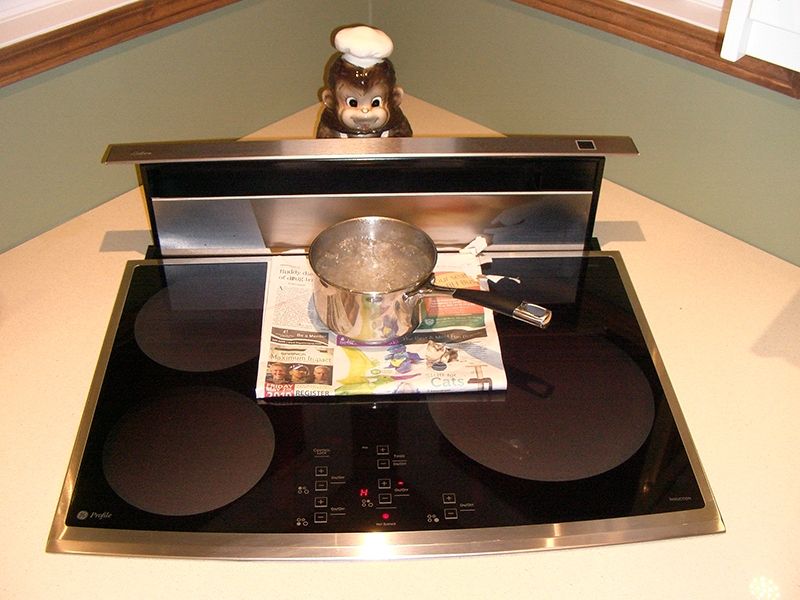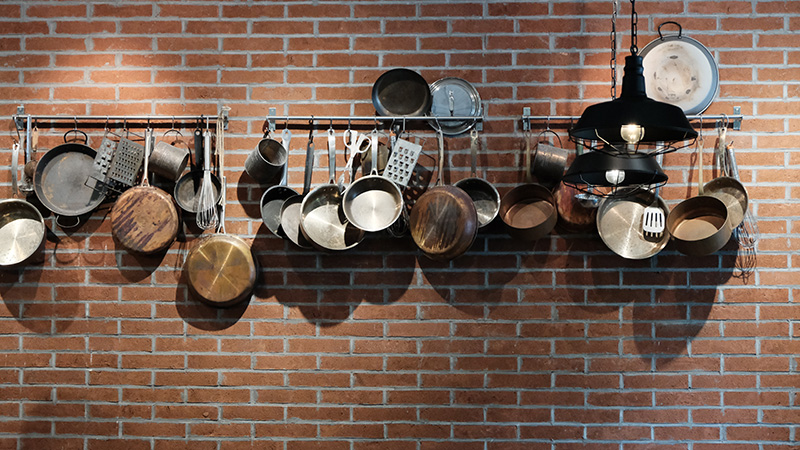How to Introduce Induction Ranges in Your Rental Units
By Kimberly Rau, MassLandlords, Inc.
A gas or electric resistance stove with oven has an average lifespan of 10 to 15 years. That means at some point in your tenure as landlord, you’ll likely be replacing one in your rental’s kitchen. Instead of going with the standard gas or electric resistance stove, we suggest you consider an induction range.

Because induction stoves only heat the pan they induce a current in, they are safer than gas or electric reduction stoves. Case in point: a pan of water at a rolling boil, with a piece of newspaper between it and the burner. (Image license: CC by SA wtshymanski wikipedia)
Induction ranges are more efficient than their traditional counterparts, more environmentally friendly and, in many ways, safer to use. But induction stoves are less popular than standard gas or electric resistance options, and many of your tenants may be unfamiliar with how to use them.
In this article, we’ll give a brief overview of induction ranges, including their features and benefits, and then move on to how to seamlessly integrate them into your rental units.
What is an Induction Stove?
Note that when we talk about induction stoves, we are referring to the cooktop of a range, a stove/oven combination, the type of appliance that most rental kitchens will have. Most induction stoves are ranges, with an oven and convection oven beneath the stove top. Stove top-only options are also available, in case you have a wall oven unit in your rental, for example.
An induction stove uses induction technology to heat cookware in a very precise and efficient manner. Though the stove is powered by electricity, the actual heating device uses the full power of electromagnetism to heat the cookware.
Here’s a very simplified explanation. The inductor coil in the stove creates a magnetic field around it. When an induction-rated pan (more on that later) is placed on top of the stove, the stove creates a current in the pan using the magnetic field. The magnetic fields change directions. This changing induces a current in the pan, which heats the metal of the pan. Because the stove only induces current in (heats) the pan, it is incredibly fast. It’s like putting the energy from the wall directly into your pan! You can boil water in two minutes or less, compared to five or more minutes with traditional stovetops that heat something else first (gas stoves heat the air around your pan; electric resistance heats a coil under your pan).
You probably have already seen induction working before. Induction is the principle behind all contactless chargers, including electric toothbrushes with sealed plastic bases and contactless phone chargers.
What are the Benefits to Induction Stoves?
As you might have guessed, induction stoves are very attractive options due to their efficiency. Induction stoves only create heat through the pots and pans on their surfaces, instead of having to heat a whole burner that then must heat a pan and its contents. According to Carbon Switch, a site devoted to explaining and combatting climate change, an induction stove converts 90% of its energy to cooking heat. Electric resistance stoves convert 74% of their energy to cooking heat, gas, just 40%. This enhanced performance saves time, and can lower energy costs.
Induction stoves also result in less air pollution. Natural gas stoves produce many indoor air pollutants, including nitrous oxides and carbon monoxide, which induction stoves are free of. Induction stoves also can’t blow up your house, which is a rare but serious concern with gas stoves. The Merrimack Valley gas explosions in 2018 killed one person and forced 30,000 people to evacuate their homes.
Lack of explosions aside, there are other safety benefits to induction stoves. Because the stove does not have to superheat a burner to heat the pan, the surface of the stove does not get hot enough to create serious burns. And, once a pot is removed from the stove, the current stops, and the stove top cools relatively quickly. This is a real bonus for homes with small children or pets.
From a practical standpoint, induction stoves are easy to keep clean. Because only the area directly under the pan heats, food splatters do not cook to the surface of the stove. This makes cleanup a breeze. To keep the stovetop free of scratches, your tenants should make sure that the bottom of the pans they use are kept clean and smooth (this would also be a concern for a glass-top electric resistance stove). Induction ranges also have convection ovens; this is a marvelously convenient way to cook lots of foods.
Because induction stoves as so efficient, you will not need the same size ventilation hood that you would with a gas stove. One report suggests that only 40% of the heat from a gas stove goes into the pan. The other 60% goes into the air, and you need a strong hood to get all of those fumes out of the air. On the other hand, 90% of the heat produced with an induction stove goes into the pan. You will have some heat and moisture that needs to be ventilated, but nowhere near the amount that you must accommodate with gas stoves. If you already have a hood in place, this may be a non-issue; if you are fully renovating a kitchen, this is good news for you and your contractor. You should still install a hood, but you won’t need one as powerful as you might for a gas stove.
Induction stoves have an expected lifespan of 10,000 working hours. Depending on how frequently your tenant cooks, that works out to around 10 years, according to an article in USA Today. That’s not really any different from electric or gas stoves, where budget models may last eight to 10 years, and fancier models may keep going for up to 15 (some especially top-tier gas stoves may last 20 years). And induction stoves are often pricier than other options, though costs have dropped in recent years. But considering how much more efficient they are, induction ranges still come out ahead.
How to Install an Induction Stove in Your Rental Property
If you are starting with an electric resistance stove, changing over to induction is easy. You don’t need a plumber to install an electric range. Depending on when your kitchen was last done, you may need to upgrade your stove’s outlet to a four-prong outlet, which an electrician can easily do. But first, you need to check on the electricity that runs to that outlet.
Head to your basement (or wherever your breaker box is) and find the breaker that feeds your stove. It should be dedicated just for the stove, and clearly labeled as such. If you have fuses, you are going to need to address that with an electrician before you can install an induction stove.
Once you’ve found the stove’s breaker, check its amperage. Many household circuits are rated at 15 or 20 amps, but stoves need a bit more power. A 30-amp line is adequate; a 50-amp line will get you the fastest possible stove.
If you already have an electric resistance stove, your breaker box may already have sufficient power on that circuit. If you have a gas stove, your amperage may not be sufficient, and you’ll need to upgrade your breaker box. (This should be on your renovation checklist anyway, as legislative proposals are in the works that would allow communities to restrict or ban the use of gas-powered heating systems and appliances.)
Here’s another reason to try induction. If you want to get your rental properties ready in time for the Paris Agreement’s goal of “net zero” carbon emissions by 2050, installing an induction stove in lieu of a gas range is a great way to start. You will need a professional plumber to cap your gas line, but won’t need them to install the induction stove. Capping the gas and running the appropriate electrical can be done at different times by different licensed tradespeople.
The only other concern is that all stoves should have an anti-tip bracket installed, an easy and inexpensive project.

Not all cookware is induction-rated. The good news is, a set of induction-friendly pots and pans is relatively cheap and makes a great gift at lease signing. (Image license: Unsplash)
How to Introduce Induction Stoves to Your Tenants
One thing you will want to remember is that induction stoves require certain types of pans to operate. Your tenant may have pans that will work. The way to test it is to take a strong magnet and hold it against the bottom of a pan. If the magnet sticks strongly, it will work with an induction stove. Copper, glass and aluminum pans will not be compatible with induction stove tops; pans made of carbon steel, cast iron or stainless steel are likely to be compatible.
But a great way to get your tenants excited about the induction stove is to include a set of induction-friendly pans as a lease-signing gift (along with an explanation of how to use the stove), or to give a set of pans when you switch out the stove. A set of pans is relatively inexpensive and will ensure that the stove is used properly. Once your renter tries it, we bet they won’t want to go back to traditional stoves ever again.
A note: Some induction ranges have panels that may be confusing at first, especially if your tenants are used to using knobs to adjust temperature ranges. Some induction stove models now come with knobs to ease the transition.
Common Renter Issues with Induction Stoves
Your tenant may love their new induction stove, but as with anything new, there may be a bit of a learning curve as they get used to things. Here are some issues you may run into, and how to prevent them from happening in the first place.
If you buy your renters induction-friendly nonstick cookware, they may end up scratching it badly.
This is a common issue if your renter doesn’t realize that using metal utensils is harmful to nonstick pots and pans.
How to prevent this: If you provide cookware, also include some inexpensive nylon or wooden utensils. Take a moment to educate them about the potential dangers of ingesting Teflon coating scraped off by metal utensils.
Your renter may crack the top of the stove if they drop something heavy on it.
This is not normal wear and tear, and is a clear security deposit issue, but the sanitary code requires you to get that stovetop up and running again mid-tenancy. You’re going to have to get the stove fixed.
How to prevent this: Once again, an ounce of prevention is worth a pound of cure. Educate your renters on the perils of a glass cooktop. They look great, but they won’t just dent like metal does if something lands on them. Remind them to use two hands when lifting any pot, and to use caution when getting anything out of a cabinet above or beside the stove.
Your renter may have trouble getting the stove to work.
Your tenant may call you and say the stove isn’t working: They are getting a mysterious “P” or other symbol or noise, and the pan is not getting hot.
This is either because the pan is not induction compatible, or the pan is too small for the coil. Some stove models will not accommodate an unusually small pan on its power burner. The stove will sense this and refuse to run.
Solution: Ask them to test their pan for compatibility using the magnet trick. If this isn’t the issue, ask them to try using a larger pan that is induction compatible. If the problem persists, consult your owner’s manual.
Conclusion
An induction stove is certainly not the cheapest stove or range you could purchase for your rental unit, but the cheapest option is not always the best option, and this is the case here. Induction stoves are safer, more efficient cooking appliances. Installing one puts you in compliance with proposed legislation that will eventually ban new gas stoves in housing units, and updated kitchen appliances are always attractive to potential tenants.
There is one trade-off to be aware of: Induction stoves heat the air space less, which means in the summer, you won't need to spend as much energy cooling your living space. But in the cooler months, you may find you are relying on your home heating system more, as the stove will not be warming the air in the kitchen. This was submitted by our member Stephen Bosco, who also wrote:
"Good article on induction ranges. I've installed them in a few units, and I did exactly what the article suggested: bought a set of induction friendly nonstick pans for the tenant. I figure that will be another $200 every time the unit turns over, but, I suppose that's a tolerable expense."
Have you installed induction stoves in any of your rental units? If you have an experience you’d like to share, or would be willing to provide a tutorial for other landlords, we’d like to hear from you! Email us at hello@masslandlords.net.




